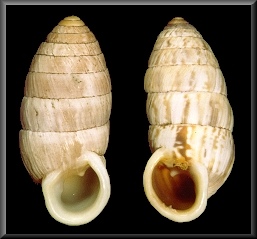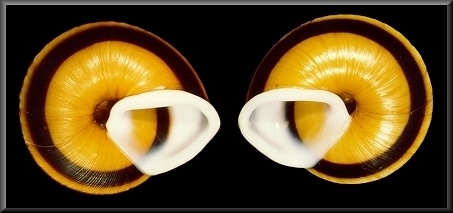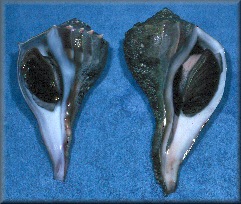| Anomalous Sinistrality | ||||||
| By Phil Poland | ||||||
| Say what? Once in a great while, if you’re a lucky and observant snailer, you’ll come across one. Something doesn’t look right and - "Holy Cow! I got one!" This is exactly what I said when I found my latest sinistral, or left-handed, snail several months ago. Sinistral shells are mirror-images of the shells of normal (in most species) snails. No one has ever developed a plausible explanation for the overwhelming predominance of righthandedness, or dextrality, among gastropods. Some hints that problems may arise for sinistral snails include (as noted by our own Harry Lee and others) a much higher rate of sinistrality occurring in utero (or at least in egg cases), suggesting a higher mortality rate for the abnormal snails. Sinistral shells are never sought, just found, as by-products of more realistic snailing goals. I seem to have found more than my fair share of these, and I’m sure it has to do with sheer numbers examined. Techniques I use to find snails lead to my having to look at a lot of specimens over time. I use a net routinely to sample grasses, sand, mud, algae, etc. Each scoop may bring up dozens of individuals, almost all returned immediately to the environment. I also use sieves to uncover the really small species and, in this way too, look at thousands of specimens over time. What are the odds of finding one? R. Tucker Abbott estimated that one in five thousand Prunum apicinum (Menke, 1828) (Common Atlantic Marginella), a common marginellid in Florida, might be sinistral. The rate is probably far lower for most other species, the vast majority of which are unknown in sinistral condition. |
||||||
Many years ago, when mammoths still walked the earth and snailers were not spat upon, I, as a beginning collector, had some luck. In southeast Florida, little white land snails, Cerion incanum (A. Binney, 1851) (Gray Cerion), are found clinging to grass stems and shrubs near the shore. I was intrigued with the few in a hundred that were marked with brown, and the few in a thousand that were ribbed. I looked for these forms and, as a result of the scrutiny, found four sinistrals in a year in one population on Boca Chica Key near Key West. I was new at this. My success and Abbott’s estimate left me thinking – "Ho hum, another one." I gave them away. As it turns out, this population was quite unusual and the frequency of occurrence within it (one in a few thousand?) may suggest a genetic basis for at least some sinistrality. A few years later, back in the Keys and using a net this time, I found Abbott’s sinistral Prunum. In the quiescent shallows behind Missouri Key, I was picking up dozens of large pale forms of the species in each scoop and – "Oh gee!" Over the next 28 years of scooping I found two more, both the typical brown-banded form, and both from Boca Ciega Bay near St. Petersburg. Prunum apicinum I have seen thousands of and I suspect that Abbott was not far off. I’ve had very good luck with marginellids. One winter, about ten years ago, a bloom of a related species, Prunum cf. avenaceum (Deshayes, 1844) (cf. Little Oat Marginella), occurred in the same bay. I was shaking them out of dead pen shells and cans found in grassy shallows into my net and – "Wow!" I wanted to surprise a collector friend with it and gave him a matched set of both a dextral and the sinistral I’d found, along with some other specimens. As it turns out, he didn’t recognize it as special and either misplaced it or pitched it! "!@#$!" I’ve examined several hundred of this species. Another sinistral marginellid, Pugnus serrei (Bavay, 1911),* was found as I examined sieved material rinsed from clumps of the alga Halimeda from a Keys location. I’ve seen fewer than a hundred specimens of this species. I visited a quiet Florida Bay location near Marathon, about halfway between Key West and Miami, and found yet another sinistral marginellid, Volvarina avena (Kiener, 1834) (Orange-band Marginella). One clump of intertidal Halimeda yielded about a dozen specimens, including the prize. I’ve examined fewer than two hundred of this species. Another sinistral marginellid, Pugnus serrei (Bavay, 1911),* was found as I examined sieved material rinsed from clumps of the alga Halimeda from a Keys location. I’ve seen fewer than a hundred specimens of this species. I visited a quiet Florida Bay location near Marathon, about halfway between Key West and Miami, and found yet another sinistral marginellid, Volvarina avena (Kiener, 1834) (Orange-band Marginella). One clump of intertidal Halimeda yielded about a dozen specimens, including the prize. I’ve examined fewer than two hundred of this species. My guess (based on my experience and reports from other collectors) is that the sinistrality rate for marginellids in general is close to Abbott’s estimate for P. apicinum.
"They don’t grow on trees, ya know." However, they can be found there. A few months back, at the height of landsnail season (funny, but motel rates remained low), I collected Caracolus marginella (Gmelin, 1791) (Banded Caracol), a large and attractive invader from the Greater Antilles. These snails are reasonably common in an area of Miami between Coconut Grove and downtown during the rainy months. I have to admit that I didn’t notice the single sinistral when it was collected. Hey, it’s dark in those woods! Why title this story "Anomalous Sinistrality?" Firstly, I want you to have an opportunity to say it quickly four times. Secondly, not all sinistrals are anomalous. Our own Florida Busycon sinistrum Hollister, 1958 (Lightning Whelk) is a dramatic example of a normally sinistral snail. The winter before last, I braved chill winds and rain on the offshore bars near Cedar Key. My effort was rewarded with the find of a large female of the species, anomalously dextral.
On my latest trip to the Keys, I was wandering down a path near the shore, just before sunset, and spotted an old favorite of mine on a bush, a maculated Cerion, and this takes us back to the beginning of this story – "Holy cow!" I should mention that looking at large numbers of specimens leads to finding other abnormalities. A few months ago, my snailing partner pulled up a snow-white Prunun apicinum in Tampa Bay – a true albino, not a pale form. I have my own lists of albino and orange forms (partial albinism). High-spired and strangely-spined ones show up too. Shall we tackle these? *Common name is not listed in Turgeon, D. D., J. F. Quinn, Jr., A. E. Bogan, E. V. Coan, F. G. Hochberg, W. G. Lyons, P. M. Mikkelsen, R. J. Neves, C. F. E. Roper, G. Rosenberg, B. Roth, A. Scheltema, F. G. Thompson, M. Vecchione, and J. D. Williams, 1998. Common and scientific names of aquatic invertebrates from the United States and Canada: Mollusks, 2nd edition. American Fisheries Society, Special Publication 26, Bethesda, Maryland, U.S.A. Editor’s Comments: Reverse-coiled gastropods collected by Phil Poland (13 specimens of 7 species):
|


